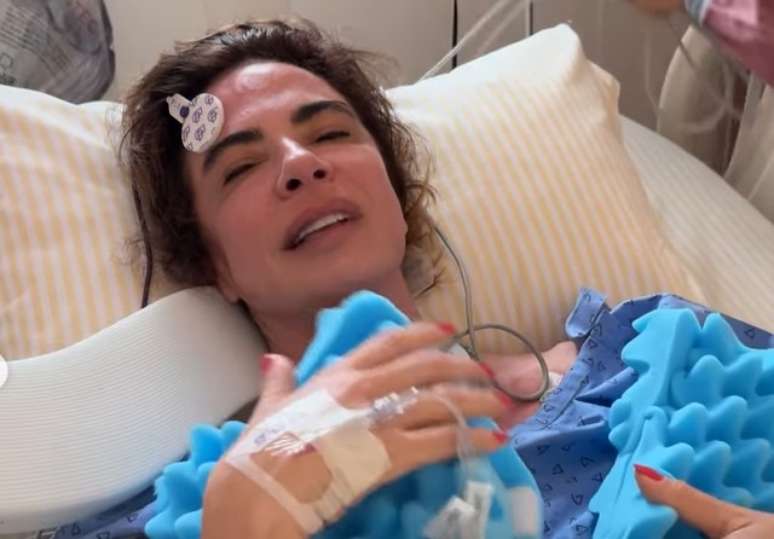The presenter has already recorded some videos that complain about the postoperative
Luciana Gimenez, 55, has undergone an emergency intervention to correct a cervical hernia record and is still admitted to the Israeli hospital Albert Einstein in San Paolo. Since then, the presenter has recorded some videos that complain about the postoperative period and has called it “torture” as it is an active person and for now he has swelling and limitations.
What is the hernia of the cervical disc?
The hernia of the cervical disc is a condition in which the wrist nucleus of the intervertebral disc moves beyond the fibrous ring and can compress the nerve structures such as the nerve roots and the spinal cord.
“This condition usually occurs due to the natural degeneration of the disc over time, but can also be caused by factors such as trauma, repetitive movements and bad posture. The progressive wear of the cervical discs leads to the loss of elasticity and resistance, to facilitate the tear of spinal records and the director of the spinal and traumatology of Belo Horizonte.
Symptoms and surgical indications
The symptoms of the cervical disc vary according to the position and severity of the compression of the nerve structures. The most common include neck pain that can radiate towards shoulders and arms, tingling or numbness in the upper limbs, muscle weakness and reduced motor coordination.
“In the most serious cases, there may be compression of the spinal cord, which leads to a condition called cervical myelopathy, which can cause difficulty walking, loss of dexterity in the hands and even alterations of control of the sphincter”, says the neurocarice Felipe Mendes, an expert in columns and member of the Brazilian neurosurgery society.
The expert explains that the initial treatment is generally conservative, using drug relief drugs and inflammation, physiotherapy and, in some cases, infiltrations for temporary relief of symptoms.
“Surgery can be indicated when conservative treatment is a failure after 6-12 weeks, when the patient has a progressive neurological deficit (as a significant muscle weakness) or when there are signs of compression of the spinal cord, which can lead to irreversible sequences if not treated,” he adds.
How is surgery for the hernia of the cervical disc?
The hernias of the disc in the cervical region can be treated in many ways. However, the most common surgery for the hernia of the cervical disk is the front cervical discerptomy with merger (ACDF).
“In this procedure, the surgeon accesses the cervical column by means of a small incision in the front of the neck and removes the errnia disc, decominging the nerve structures concerned,” says dr. João Vitor Lima, a neurosurgeon specialized in spine.
To maintain the stability and height of the intervertebral space, the doctor explains that a bone graft or synthetic spacer is inserted, promoting bone merger between the vertebrae.
“In some cases, a plate with screws for additional fixation is also used. Another surgical option is cervical arthroplasty, in which the hernia disc is replaced by an artificial prosthesis, which allows the conservation of cervical mobility,” he says.
The postoperative period of cervical surgery is generally well tolerated, with hospital discharges in 24-48 hours.
“The use of the cervical collar can be temporarily recommended and the return to light activities usually occurs in 2-6 weeks. The complete bone merger lasts about 3-6 months and physiotherapy rehabilitation is essential to restore strength and muscle mobility,” he adds.
Despite being a safe surgery, the doctor explains that there are risks that should be considered.
The possible complications include:
- The injury of the nerve structures (although rare, can cause permanent neurological deficit)
- infection
- temporary dysphagia (difficulty in swallowing)
- Inadequate bone merger formation (pseudoarthrosis, which can request a new surgery) and syndrome of the adjacent segment, a condition in which the alleged discs in the operated area can undergo an accelerated degeneration.
“Therefore, the surgery decision should be taken on the basis of a detailed clinical evaluation and imaging exams, ensuring that the treatment is individualized and suitable for each patient,” he concludes.
Source: Terra
Ben Stock is a lifestyle journalist and author at Gossipify. He writes about topics such as health, wellness, travel, food and home decor. He provides practical advice and inspiration to improve well-being, keeps readers up to date with latest lifestyle news and trends, known for his engaging writing style, in-depth analysis and unique perspectives.






![Such a wonderful sun in advance: Summary of Episode of Thursday May 1, 2025 [SPOILERS] Such a wonderful sun in advance: Summary of Episode of Thursday May 1, 2025 [SPOILERS]](https://fr.web.img4.acsta.net/img/d0/ab/d0ab8371c779e444a22a97cbde9ac844.png)

